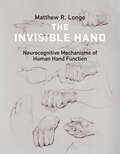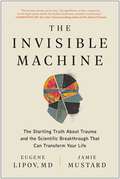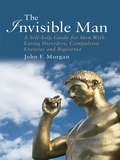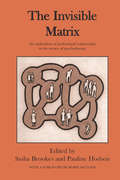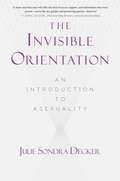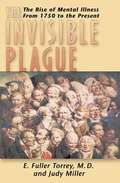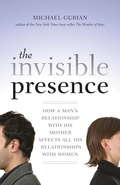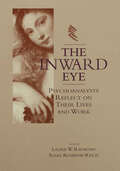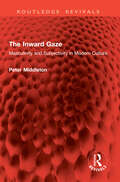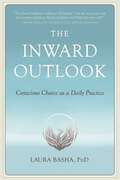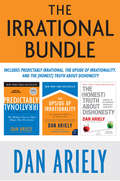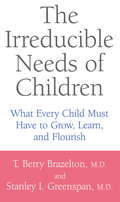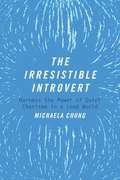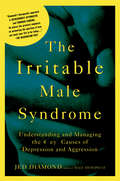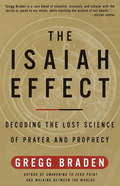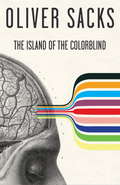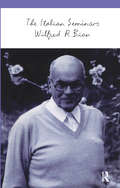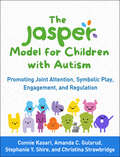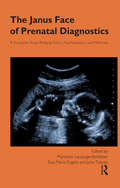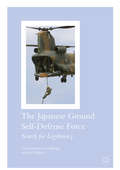- Table View
- List View
The Invisible Hand: Neurocognitive Mechanisms of Human Hand Function
by Matthew R. LongoHow the &“invisible hand&” of the nervous system makes the human hand such an evolutionary success.The hand has a central role in both human evolution and cultural development—in our descent and in our ascent. It is, Immanuel Kant said, &“the visible part of the brain.&” It is the invisible that concerns Matthew Longo in The Invisible Hand, a wide-ranging, deftly written account of the neural and cognitive mechanisms that have made a seemingly ordinary physical appendage an extraordinary tool in the evolution of humanity.The hand has been the focus of an enormous amount of research from a dizzying range of disciplines, from anatomy, psychology, and neuroscience to evolutionary biology and archaeology. With the concept of the invisible hand, Longo integrates and contextualizes the findings from these disparate fields to show how the neurocognitive mechanisms that comprise the invisible hand are central to understanding a wide array of phenomena, including basic sensory and motor function, space perception, gesture, and even the self. More generally, he contends that the extraordinary abilities of the hand arise precisely from the complementary nature and tight integration of the visible and invisible hands—a proposition that leads deep into topics as diverse as haptics, tool use, handedness, phantom limbs, and evolution. His work elucidates and significantly expands a key chapter of the story of human evolution and culture as manifested in the human hand.
The Invisible Machine: The Startling Truth About Trauma and the Scientific Breakthrough That Can Transform Your Life
by Jamie Mustard Eugene LipovPenCraft Book Awards 2023 Non-Fiction Runner Up The world has long misunderstood trauma. Now, leading experts in the field have a radical new understanding of post-traumatic stress . . . and a surprising new treatment to reverse it could have profound implications for medicine, mental health, and society. Despite its prevalence, post-traumatic stress, PTSD, is often seen as an unbeatable lifelong mental disorder. However, top trauma doctors and neuroscientists now understand that the result of trauma is not a disorder, but rather a physical injury—and while invisible to the naked eye, the posttraumatic stress injury (PTSI) can now be seen on a scan. Most importantly, the effects of PTSI are reversible. Meet Dr. Eugene Lipov. His research and partnerships have led to an amazing discovery that all trauma has at its root a single piece of human hardware: the sympathetic nervous system, controlling the fight-or-flight response. Anyone who has endured trauma, including long-term microdoses of emotional stress, can have this injury. Dr. Lipov has pioneered a safe, 15-minute procedure that reverses the injury, relieving mild to extreme symptoms of PTSI—irritability, hypervigilance, anxiety, insomnia, and more—for survivors to combat soldiers to the everyday person. Weaving hard science with moving human stories, The Invisible Machine reveals how this treatment was developed. It also tells the incredible story of the unlikely team, including the doctor, an artist, Special Forces leadership, and a sheriff, who are working together to change our understanding of post-traumatic stress and why it matters to society. Coauthored by artist and innovator Jamie Mustard and in collaboration with writer Holly Lorincz, The Invisible Machine weaves hard science with moving stories of warriors, prisoners, and ordinary people to provide a stark new understanding of the human condition. The implications for a better, pain-free world are astounding—and that world could be nearer than we think.
The Invisible Man: A Self-help Guide for Men With Eating Disorders, Compulsive Exercise and Bigorexia
by John F. MorganIncreasingly boys and men are suffering with eating disorders and related body image problems. Some have full-blown conditions such as anorexia nervosa, bulimia, binge eating, compulsive exercising or bigorexia. Others are distressed by slightly lesser degrees of disordered eating or over-exercise and seek ways of overcoming their problems. The Invisible Man applies the latest research to produce a practical, problem-focused self-help manual for men with eating disorders and body image problems. Divided into four sections, this evidence-based survival kit covers: the wider cultural context of male body image problems features unique to men science fact and science fiction a 7 stage approach to treatment. By combining the science of cognitive behaviour therapy with motivational enhancement and problem-solving therapies, The Invisible Man provides help to all men with body image disorders, as well as families and professionals involved in their care.
The Invisible Matrix: An Exploration of Professional Relationships in the Service of Psychotherapy
by Sasha BrookesThis book is about the therapist's professional matrix, both visible and invisible. It is about how clinicians manage the web of professional connections that inform, control, bother and console us whilst we struggle with our client's inner world.
The Invisible Orientation: An Introduction to Asexuality
by Julie Sondra DeckerLambda Literary Award 2014 Finalist in LGBT NonfictionForeword Reviews’ INDIEFAB Book of the Year Award 2014 Finalist in Family & RelationshipsIndependent Publisher Book Awards 2015 (IPPY) Silver Medal in Sexuality/RelationshipsNext Generation Indie Book Awards 2015 Winner in LGBT--What if you weren't sexually attracted to anyone?A growing number of people are identifying as asexual. They aren’t sexually attracted to anyone, and they consider it a sexual orientation-like gay, straight, or bisexual.Asexuality is the invisible orientation. Most people believe that "everyone” wants sex, that "everyone” understands what it means to be attracted to other people, and that "everyone” wants to date and mate. But that’s where asexual people are left out-they don’t find other people sexually attractive, and if and when they say so, they are very rarely treated as though that’s okay.When an asexual person comes out, alarming reactions regularly follow; loved ones fear that an asexual person is sick, or psychologically warped, or suffering from abuse. Critics confront asexual people with accusations of following a fad, hiding homosexuality, or making excuses for romantic failures. And all of this contributes to a discouraging master narrative: there is no such thing as "asexual.” Being an asexual person is a lie or an illness, and it needs to be fixed.In The Invisible Orientation, Julie Sondra Decker outlines what asexuality is, counters misconceptions, provides resources, and puts asexual people’s experiences in context as they move through a very sexualized world. It includes information for asexual people to help understand their orientation and what it means for their relationships, as well as tips and facts for those who want to understand their asexual friends and loved ones.
The Invisible Plague: The Rise of Mental Illness from 1750 to the Present
by E. Fuller Torrey Judy MillerThe prevalence of insanity, which was once considerably less than one case per 1,000 total population, has risen beyond five cases in 1,000. Why has mental illness reached epidemic proportions? What are the causes of severe mental illness?
The Invisible Presence: How a Man's Relationship with His Mother Affects All His Relationships with Women
by Michael GurianWhether he's conscious of it or not, a man's mother is the model for just about every relationship with a woman he has for the rest of his life. Sometimes it's obvious (just ask his wife or girlfriend), sometimes it's more subtle, but when you see it, it becomes crystal clear. For fifteen years, this book has helped men understand their mothers' pervasive influence over the way they relate to women--both the positive and negative aspects of it. But more than that, it has helped thousands of men break free of old relationship patterns. Gurian gives men a wealth of practical exercises and meditations they can use to recognize their mothers' influence in relationships, and to establish a healthy and rewarding new basis for relationships that will benefit themselves and the women in their lives as well. This new edition of the book formerly titled Mothers, Sons, and Lovers includes a new preface and study questions by the author.
The Inward Eye: Psychoanalysts Reflect on Their Lives and Work (Psychoanalytic Therapy Ser.)
by Laurie W. Raymond Susan Rosbrow-ReichA central, although unappreciated, dimension of psychoanalysis is the complex oral tradition through which analysts verbally reconstruct their lives and careers. The Inward Eye captures a significant portion of this tradition. In a series of interviews initially conceived as an aspect of their psychoanalytic education, Laurie Raymond and Susan Rosbrow-Reich skillfully elicit the fascinating personal stories of 16 senior analysts. The interviewees, who represent diverse theoretical traditions and cultural backgrounds, share a willingness to reflect candidly on their preanalytic years, their formative influences, their entry into psychoanalysis, and their relationships with mentors and colleagues. Out of this skillfully guided journey into the personal past emerges a vital human context for understanding the theoretical preferences and clinical styles of analysts as diverse as Arthur Valenstein, Joseph and Anne-Marie Sandler, Jacob Arlow, Andre Green, Leo Stone, Leo and Anita Rangell, Edward Weinshel, Merton M. Gill, Albert Solnit, W. Clifford M. Scott, James McLaughlin, Rebecca Solomon, Joyce McDougall, M. Robert Gardner, and Janine Chasseguet-Smirgel. Raymond and Rosbrow-Reich succeed in capturing the essential humanity of all their interview subjects, in showing how their subjects' lives outside the consulting room have shaped, and in turn been shaped by, the analytic identities they assume behind the couch. An engrossing read, wonderfully revelatory of its creative subjects, The Inward Eye is also an invaluable contribution to psychoanalytic history.
The Inward Gaze: Masculinity and Subjectivity in Modern Culture (Routledge Revivals)
by Peter MiddletonFirst published in 1992, The Inward Gaze looks at men’s fantasies and self-images from a wide range of texts (notably boy’s superhero comics, modernist literary classics, and a Freudian case-study) to discuss the theories of subjectivity, masculinity, and emotion.The author explores the split between the experience-based claims of the men’s movement and the discourse theories of postmodernism. Does this division reveal a continuing refusal of masculine self-awareness? Why does postmodernist theory investigate desire and ignore emotion?This is a ground-breaking and controversial book which seeks to reformulate the way we think about men’s subjectivity. Its interdisciplinary approach weaves together material from many different sources and will be of vital interest to students of literature, cultural studies, gender studies, and psychoanalysis.
The Inward Outlook: Conscious Choice as a Daily Practice
by Laura BashaEvery day, we take in data from the world around us and store that data in our intellect. Then, without conscious awareness, we listen to that data—a process we call &“thinking&”—and use what it tells us to inform our decisions. But living our lives this way means always living in the past, and it limits us more than we think.In The Inward Outlook, psychologist Laura Basha shares how to discern this habitual way of thinking from the innate wisdom and common sense that we all have available to us at all times. Once we can see this distinction between personal thinking from the past and in-the-moment, impersonal, diffuse thinking, we are awakened to the conscious choice point, which allows us to make choices with awareness and to release judgment of ourselves and of others. We then consciously create ourselves to be the best version of ourselves we can be: our authentic, powerfully creative, compassionate selves. A powerful guide to accessing one&’s own innate health, well-being, and wisdom, The Inward Outlook is an accessible exploration of a principle-based paradigm that educates people in the role thought plays in creating their experience of reality—and a road map to cultivating inspired focus, accomplishment, and peace of mind in one&’s life.
The Irrational Bundle
by Dan ArielyDan Ariely's three New York Times bestselling books on his groundbreaking behavioral economics research, Predictably Irrational, The Upside of Irrationality, and The (Honest) Truth About Dishonesty, are now available for the first time in a single volume,
The Irrational Bundle
by Dr Dan ArielyDan Ariely's three New York Times bestselling books on his groundbreaking behavioral economics research, Predictably Irrational, The Upside of Irrationality, and The (Honest) Truth About Dishonesty, are now available for the first time in a single volume.
The Irreducible Needs of Children: What Every Child Must Have to Grow, Learn, and Flourish
by Stanley I. Greenspan T. Berry BrazeltonWhat do you get when you cross an esteemed child psychiatrist with a noted pediatrician, both at the apex of their abilities? A darned important book, that's what. --"Library Journal" (starred review)
The Irresistible Introvert: Harness the Power of Quiet Charisma in a Loud World
by Michaela ChungLearn the tools to shed your mask of extroversion, develop your own magnetism, and reveal the true you.One third to one half of Americans are introverts in a culture that celebrates-even enforces-an ideal of extroversion and a cult of personality. Political leaders are charismatic, celebrities bask in the spotlight, and authority figures are assertive. It is no surprise that a "quiet revolution” has begun to emerge among the "invisible” half of the population, asserting that they are just as powerful in their own unique ways.The Irresistible Introvert embodies the spirit of this revival and breaks down the myth that charisma is reserved for extroverts only. This mini manifesto shows introverts how to master the art of quiet magnetism in a noisy world-no gregariousness required! Within these pages, you’ll discover how to shed the mask of extroversion and reveal a more compelling (and authentic) you. You’ll also learn how to: Master the inner game of intrigue Manage your energy for optimal engagement Create an emotional ecosystem for charisma Establish introverted intimacy Cultivate communication skills for quiet typesAs a "professional” charismatic introvert, author Michaela Chung demonstrates that you no longer have to forcefully push yourself outward into the world against your nature, but can rather magnetize people inward toward the true you. In the process, you’ll learn to embrace your "innie life” and discover potential you never knew you had.
The Irritable Male Syndrome: Understanding and Managing the 4 Key Causes of Depression and Aggression
by Jed DiamondFrom the bestselling author of Male Menopause comes another life-transforming book for men—and the women who love them—on overcoming the mood and behavior changes caused by fluctuating male hormones. Jed Diamond presents the most up-to-date research from around the globe to reveal why so many normally loving husbands, fathers, and sons suddenly become irritable, angry, and withdrawn. He identifies the four common triggers of Irritable Male Syndrome (IMS)—fluctuating testosterone levels, biochemical imbalances, loss of masculine identity, and stress—and then shows how best to treat this condition that, research shows, affects up to 30 percent of males, especially those in adolescence and midlife.Just as PMS is now acknowledged to be a problem in women, IMS is gaining recognition as an affliction among men. By revolutionizing the detection, understanding, and treatment of this condition, The Irritable Male Syndrome is bringing relief and happiness back to the lives of millions.
The Isaiah Effect: Decoding the Lost Science of Prayer and Prophecy
by Gregg BradenSeventeen hundred years ago, key elements of our ancient heritage were lost, relegated to the esoteric traditions of mystery schools and sacred orders. Among the most empowering of the forgotten elements are references to a science with the power to bring everlasting healing to our bodies and initiate an unprecedented era of peace and cooperation between governments and nations. In his groundbreaking new book,The Isaiah Effect, Gregg Braden turns to the Isaiah Scroll, perhaps the most important of the Dead Sea Scrolls discovered in 1946, to offer insight into a powerful form of ancient prayer. InThe Isaiah Effect, Braden, author ofAwakening to Zero Pointand Walking Between the Worlds, combines research in quantum physics with the works of the prophet Isaiah and the ancient Essenes. He demonstrates how prophecies of global catastrophe and suffering may only represent future possibilities, rather than forecast impending doom, and that we have the power to influence those possibilities. In addition to describing multiple futures, the Isaiah texts take us one step further, clearly describing the science of how we choose our futures. Tracing key words of Isaiah's text back to their original language, we discover how he taught a mode of prayer that was lost to the West during Biblical editing in the fourth century. Braden offers detailed accounts of how elements of this mode of prayer have been applied in a variety of situations, ranging from healing life-threatening conditions to entire villages using collective prayer to prevail during the 1998 fires in southern Peru. In each instance, the correlation between the offering of the prayer and a shift of the events in question was beyond coincidence--the prayers had measurable effects! As modern science continues to validate a relationship between our outer and inner worlds, it becomes more likely that a forgotten bridge links the world of our prayers with that of our experience. Each time we engage ourselves, our loved ones, and our communities with Isaiah's life-affirming message of hope, we secure nothing less than our future and the future of the only home we know.
The Isaiah Effect: Decoding the Lost Science of Prayer and Prophecy
by Gregg BradenSeventeen hundred years ago, key elements of our ancient heritage were lost, relegated to the esoteric traditions of mystery schools and sacred orders. Among the most empowering of the forgotten elements are references to a science with the power to bring everlasting healing to our bodies and initiate an unprecedented era of peace and cooperation between governments and nations.In his groundbreaking new book, The Isaiah Effect, Gregg Braden turns to the Isaiah Scroll, perhaps the most important of the Dead Sea Scrolls discovered in 1946, to offer insight into a powerful form of ancient prayer. In The Isaiah Effect, Braden, author of Awakening to Zero Point and Walking Between the Worlds, combines research in quantum physics with the works of the prophet Isaiah and the ancient Essenes. He demonstrates how prophecies of global catastrophe and suffering may only represent future possibilities, rather than forecast impending doom, and that we have the power to influence those possibilities. In addition to describing multiple futures, the Isaiah texts take us one step further, clearly describing the science of how we choose our futures. Tracing key words of Isaiah's text back to their original language, we discover how he taught a mode of prayer that was lost to the West during Biblical editing in the fourth century. Braden offers detailed accounts of how elements of this mode of prayer have been applied in a variety of situations, ranging from healing life-threatening conditions to entire villages using collective prayer to prevail during the 1998 fires in southern Peru. In each instance, the correlation between the offering of the prayer and a shift of the events in question was beyond coincidence--the prayers had measurable effects! As modern science continues to validate a relationship between our outer and inner worlds, it becomes more likely that a forgotten bridge links the world of our prayers with that of our experience. Each time we engage ourselves, our loved ones, and our communities with Isaiah's life-affirming message of hope, we secure nothing less than our future and the future of the only home we know.From the Hardcover edition.
The Isaiah Effect: Decoding the Lost Science of Prayer and Prophecy
by Gregg BradenSeventeen hundred years ago, key elements of our ancient heritage were lost, relegated to the esoteric traditions of mystery schools and sacred orders. Among the most empowering of the forgotten elements are references to a science with the power to bring everlasting healing to our bodies and initiate an unprecedented era of peace and cooperation between governments and nations.In his groundbreaking new book, The Isaiah Effect, Gregg Braden turns to the Isaiah Scroll, perhaps the most important of the Dead Sea Scrolls discovered in 1946, to offer insight into a powerful form of ancient prayer. In The Isaiah Effect, Braden, author of Awakening to Zero Point and Walking Between the Worlds, combines research in quantum physics with the works of the prophet Isaiah and the ancient Essenes. He demonstrates how prophecies of global catastrophe and suffering may only represent future possibilities, rather than forecast impending doom, and that we have the power to influence those possibilities. In addition to describing multiple futures, the Isaiah texts take us one step further, clearly describing the science of how we choose our futures. Tracing key words of Isaiah's text back to their original language, we discover how he taught a mode of prayer that was lost to the West during Biblical editing in the fourth century. Braden offers detailed accounts of how elements of this mode of prayer have been applied in a variety of situations, ranging from healing life-threatening conditions to entire villages using collective prayer to prevail during the 1998 fires in southern Peru. In each instance, the correlation between the offering of the prayer and a shift of the events in question was beyond coincidence--the prayers had measurable effects! As modern science continues to validate a relationship between our outer and inner worlds, it becomes more likely that a forgotten bridge links the world of our prayers with that of our experience. Each time we engage ourselves, our loved ones, and our communities with Isaiah's life-affirming message of hope, we secure nothing less than our future and the future of the only home we know.From the Hardcover edition.
The Island of the Colorblind
by Oliver SacksOliver Sacks has always been fascinated by islands--their remoteness, their mystery, above all the unique forms of life they harbor. For him, islands conjure up equally the romance of Melville and Stevenson, the adventure of Magellan and Cook, and the scientific wonder of Darwin and Wallace. Drawn to the tiny Pacific atoll of Pingelap by intriguing reports of an isolated community of islanders born totally color-blind, Sacks finds himself setting up a clinic in a one-room island dispensary, where he listens to these achromatopic islanders describe their colorless world in rich terms of pattern and tone, luminance and shadow. And on Guam, where he goes to investigate the puzzling neurodegenerative paralysis endemic there for a century, he becomes, for a brief time, an island neurologist, making house calls with his colleague John Steele, amid crowing cockerels, cycad jungles, and the remains of a colonial culture. The islands reawaken Sacks' lifelong passion for botany--in particular, for the primitive cycad trees, whose existence dates back to the Paleozoic--and the cycads are the starting point for an intensely personal reflection on the meaning of islands, the dissemination of species, the genesis of disease, and the nature of deep geologic time. Out of an unexpected journey, Sacks has woven an unforgettable narrative which immerses us in the romance of island life, and shares his own compelling vision of the complexities of being human.
The Island of the Colorblind
by Oliver SacksOliver Sacks has always been fascinated by islands--their remoteness, their mystery, above all the unique forms of life they harbor. For him, islands conjure up equally the romance of Melville and Stevenson, the adventure of Magellan and Cook, and the scientific wonder of Darwin and Wallace.Drawn to the tiny Pacific atoll of Pingelap by intriguing reports of an isolated community of islanders born totally color-blind, Sacks finds himself setting up a clinic in a one-room island dispensary, where he listens to these achromatopic islanders describe their colorless world in rich terms of pattern and tone, luminance and shadow. And on Guam, where he goes to investigate the puzzling neurodegenerative paralysis endemic there for a century, he becomes, for a brief time, an island neurologist, making house calls with his colleague John Steele, amid crowing cockerels, cycad jungles, and the remains of a colonial culture.The islands reawaken Sacks's lifelong passion for botany--in particular, for the primitive cycad trees, whose existence dates back to the Paleozoic--and the cycads are the starting point for an intensely personal reflection on the meaning of islands, the dissemination of species, the genesis of disease, and the nature of deep geologic time. Out of an unexpected journey, Sacks has woven an unforgettable narrative which immerses us in the romance of island life, and shares his own compelling vision of the complexities of being human.From the Hardcover edition.
The Italian Seminars
by Wilfred R. BionThe Italian Seminars, previously unpublished in English, comprises lectures W.R. Bion gave in Rome, in 1977. The volume consists of questions from the floor and Bion's fascinating and, at times, controversial answers. The lectures are divided in two: the first part was organized by the Italian Psychoanalytical Society and the second by the Via Pollaiolo Research Group. Bion's replies examine such diverse subjects as difficulties in the interaction between the therapist and the patient; music and psychoanalysis; non-verbal communication in the consulting room; and methodology in psychoanalysis.
The JASPER Model for Children with Autism: Promoting Joint Attention, Symbolic Play, Engagement, and Regulation
by Connie Kasari Amanda C. Gulsrud Stephanie Y. Shire Christina StrawbridgeThis full-color, clinician-friendly manual is the authoritative guide to implementing the Joint Attention, Symbolic Play, Engagement, and Regulation (JASPER) intervention. With a strong evidence base, JASPER provides a clear, flexible structure to bolster early skills core to social communication development. The authors show how to assess 1- to 8-year-olds with autism spectrum disorder (ASD), set treatment targets, choose engaging play materials, tailor JASPER strategies to each individual, and troubleshoot common challenges. In a convenient large-size format, the manual features case examples, learning exercises, and reproducible clinical tools. At the companion website, clinicians can download and print the reproducible materials as well as a supplemental annotated bibliography.
The Jacobs Foundation Series on Adolescence: Self-Regulation in Adolescence
by Gabriele Oettingen Oettingen, Gabriele and Gollwitzer, Peter M. Peter M. GollwitzerDuring the transition from childhood to adulthood, adolescents face a unique set of challenges that accompany increased independence and responsibility. This volume combines cutting-edge research in the field of adolescence and the field of motivation and self-regulation to shed new light on these challenges and the self-regulation tools that could most effectively address them. Leading scholars discuss general principles of the adolescent period across a wide variety of areas, including interpersonal relationships, health and achievement. Their interdisciplinary approach covers perspectives from history, anthropology and primatology, as well as numerous subdisciplines of psychology - developmental, educational, social, clinical, motivational, cognitive and neuropsychological. Self-Regulation in Adolescence stresses practical applications, making it a valuable resource not only for scholars, but also for adolescents and their family members, teachers, social workers and health professionals who seek to support them. It presents useful strategies that adolescents can adopt themselves and raises important questions for future research.
The Janus Face of Prenatal Diagnostics: A European Study Bridging Ethics, Psychoanalysis, and Medicine
by Eve-Marie Engels Marianne Leuzinger-Bohleber John TsiantisCoping with modern technology in the life sciences (biology and medicine) became a major issue for people living in the Twentieth Century, and continues to be so in the present century. Biotechnology creates new opportunities and possibilities, but also new dangers, risks, and ethical concerns. In this volume, ethical dilemmas in the context of a specific biomedical technology are discussed. Experts in ethics, philosophy, psychoanalysis, and medicine jointly investigated a field of prenatal and genetic research that seems particularly challenging: prenatal diagnostics. In many European countries amniocentesis, for example, is a routine diagnostic tool for women becoming pregnant after the age of thirty-five. In recent decades, enormous progress has been made in diagnosing genetically-based diseases and other serious prenatal abnormalities. Today, we know that a positive prenatal genetic diagnostic creates distress for all women and their partners, and necessitates making the difficult decision as to whether or not to allow the pregnancy to continue. As is demonstrated in this volume through the summaries of interviews with couples, the reactions of women and their partners who are facing this situation can be very different. The new and innovative interdisciplinary dialogue on this topic that is presented in this volume offers a deeper understanding of the ethical dilemmas raised by prenatal and genetic diagnostics, and explores ways to support couples in this extremely difficult situation.
The Japanese Ground Self-Defense Force
by Paul Midford Robert D. EldridgeBased on extensive Japanese-language materials, this book is the first to examine the development of Japan's Ground Self-Defense Force. It addresses: how the GSDF was able to emerge as the post-war successor of the Imperial Japanese Army despite Japan's anti-militarist constitution; how the GSDF, despite the public skepticism and even hostility that greeted its creation, built domestic and international legitimacy; and how the GSDF has responded to changes in international and domestic environments. This path-breaking study of the world's third-largest-economic power's ground army is timely for two reasons. First, the resurgence of tensions in Northeast Asia over territorial disputes, and the emphasis recent Japanese governments have placed on using the GSDF for defending Japan's outlying islands is driving media coverage and specialist interest in the GSDF. Second, the March 11, 2011 Great East Japan Earthquake and Tsunami has focused global attention on the GSDF as Japan's lead disaster relief organization. This highly informative and thoroughly researched book provides insight for policy makers and academics interested in Japanese foreign and defense policies.
